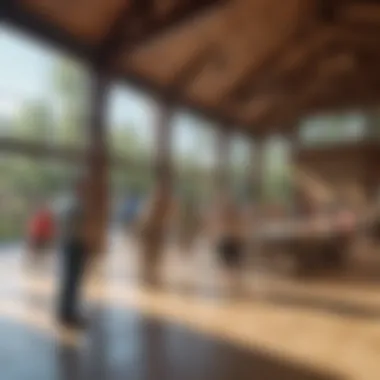Top Suburbs in Phoenix Ideal for Retirees


Intro
The choice of where to retire is one of the most significant decisions many individuals will face as they approach this life stage. With a growing population of retirees in the Phoenix area, it is essential to explore the various suburbs that cater to the needs and desires of older adults. This guide will thoroughly examine the appealing aspects of suburban living for retirees in Phoenix, encompassing aspects such as cost of living, recreational opportunities, healthcare access, and community resources. Each suburb will be assessed based on its unique features and amenities, helping retirees make well-informed choices about their next chapter.
As the sun blazes down on the desert landscape, communities in and around Phoenix offer respite for those looking to blend active living with tranquility. From vibrant social scenes to serene parks, the suburban towns can significantly enhance the quality of life for seniors. Accessibility and convenience play crucial roles in selecting the right environment, influencing factors that influence the overall satisfaction of residents.
In this article, retirees will discover which surrounding areas provide the best conditions for a fulfilling retirement. By understanding the local climate, leisure activities, and available services, individuals can better align their living situations with their preferences.
"The right environment can make the transition to retirement not just easy, but enjoyable and enriching."
Now we delve into the specific suburbs that stand out as the best options for retirees in the Phoenix area.
Intro to Retiring in Phoenix
Retirement is a significant life change that involves numerous considerations. The choice of where to retire can greatly influence one's enjoyment and overall quality of life. Phoenix, known for its warm climate and vibrant atmosphere, stands as a popular destination for many retirees.
Relocation Planning
The decision to move to Phoenix for retirement is often shaped by various elements, such as lifestyle desires, financial factors, and proximity to family. Retirees frequently seek communities that provide social activities, healthcare access, and affordable living situations. In this context, Phoenix suburbs become particularly appealing. They offer an array of choices, catering to distinct preferences and needs.
Quality of Life
Quality of life is paramount in retirement. Choosing a suburb that balances accessibility with community resources plays a vital role in enhancing daily experiences. Factors like recreational facilities, social clubs, and local events contribute to a fulfilling life. Each suburb in Phoenix has its unique characteristics that may resonate with different retirees, highlighting the need for thorough research.
Healthcare Importance
Healthcare is another crucial element for retirees. As individuals age, access to reliable medical facilities becomes necessary. Many Phoenix suburbs offer proximity to highly-rated hospitals and clinics. While exploring these options, retirees must consider the range of healthcare services available and their alignment with personal health needs.
Financial Aspects
Furthermore, financial considerations cannot be overlooked. The cost of living varies among Phoenix suburbs, affecting retirees’ budgets. Evaluating local taxes, housing costs, and daily expenses can inform better financial planning. Understanding these aspects ensures that retirees can maintain their desired lifestyle without financial strain.
In summary, retiring in Phoenix offers numerous advantages, yet it requires careful consideration of several factors. The journey includes evaluating climate, community, healthcare, and financial dynamics. This article aims to provide insights into the suburbs that best cater to retirees, ensuring informed decision-making for a rewarding retirement experience.
Why Choose Phoenix?
Phoenix stands as a notable candidate for retirees. The city offers a blend of warm weather, diverse communities, and available amenities. Retirees need to consider various aspects before relocating. These include climate, cost of living, healthcare access, and leisure activities. For many, living in an environment that is both comfortable and supportive can greatly enhance their quality of life.
Climate Considerations
The climate in Phoenix is characterized by hot, dry summers and mild winters.
- Warm Weather: Many retirees are drawn to the consistent sunny days. It is ideal for those who enjoy outdoor activities.
- Avoiding Harsh Winters: Moving to Phoenix means escaping snowy winters, appealing to those looking to maintain an active lifestyle year-round.
However, potential residents must also consider that the summer temperatures can exceed 100 degrees Fahrenheit. This might limit outdoor activities during the hottest months. It is essential to find ways to stay cool, such as swimming pools and air-conditioned spaces.
Taxes and Cost of Living
Financial aspects are vital when making a decision about retirement.


- Tax Benefits: Arizona offers retirees certain tax advantages. Social Security benefits are not taxed. There may also be lower rates for retirement accounts.
- Cost of Living: The overall cost of living in Phoenix tends to be reasonable compared to other major cities in the U.S. Housing options vary, from affordable single-family homes to luxurious condos.
- Utility Costs: While housing can be affordable, retirees should plan for higher utility costs due to the climate. Air conditioning can become a significant expense during the summer months.
Potential residents should closely evaluate their financial situation and explore local resources.
"Choosing a location for retirement can impact not just lifestyle, but financial security as well."
In summary, considering the climate and financial aspects is crucial when deciding whether to retire in Phoenix. These factors will contribute to a fulfilling retiree experience.
Key Factors for Retirees in Suburbs
When considering suburbs for retirement, several key factors influence the attractiveness and suitability of a location. For retirees, the quality of life often hinges on specific elements that can significantly affect day-to-day living. Understanding these factors allows individuals to make informed decisions that align with their lifestyle preferences and needs. The following points will cover aspects such as healthcare accessibility, community activities, and safety, each vital in supporting a fulfilling retirement experience.
Healthcare Accessibility
Healthcare is a primary concern for retirees. As individuals age, the frequency of medical visits typically increases, making convenient access to healthcare services essential. In Phoenix suburbs, the proximity to hospitals, clinics, and specialized medical facilities can greatly impact a retiree's quality of life. Access to comprehensive medical services ensures that retirees can receive timely and appropriate care when needed.
Moreover, it is also important to consider the availability of geriatric specialists and rehabilitation services. Suburbs like Scottsdale and Chandler offer robust healthcare networks featuring well-regarded hospitals such as HonorHealth and Dignity Health. These centers provide a range of services, from primary care to specialized treatments.
In addition to facilities, having transportation options is crucial. Public transit, ride-sharing services, or even communities with shuttle services can facilitate easy access to necessary healthcare resources.
Community Activities and Social Engagement
Social engagement plays a vital role in mental and emotional well-being during retirement. A supportive community can help retirees maintain an active lifestyle and foster connections with others. Suburbs that offer diverse recreational activities, cultural events, and clubs cater to the needs of an aging population.
For instance, neighborhoods like Peoria and Tempe feature community centers and libraries, often serving as hubs for social activities. These centers usually offer fitness classes, arts and crafts workshops, and educational seminars tailored to retirees. Club membership in organizations, such as the active adult community groups, can also provide opportunities for social interaction and personal development.
Participating in volunteer opportunities not only enhances one’s sense of purpose but also deepens community ties. Retirees can find satisfying ways to contribute while meeting new people.
Safety and Security
Safety is paramount for retirees. A low crime rate and community safety measures help enhance peace of mind. Suburbs that prioritize safety measures, such as neighborhood watch programs, street lighting, and active community patrols, tend to attract retirees.
When researching potential suburbs, reviewing local crime statistics provides valuable insights. Websites like local law enforcement agencies and community reports can guide exploration of neighborhoods with strong safety records.
Additionally, the environment plays a role. Setting within low-traffic areas and having walkable neighborhoods adds another layer of security. Well-maintained public spaces encourages outdoor activities while fostering a sense of community.
"When retirees consider a suburb, safety is one of the primary factors that influence their decision. A safe environment positively impacts their retirement experience."
In summary, evaluating healthcare accessibility, community engagement opportunities, and safety measures creates a framework for making informed decisions about retirement locations. These factors not only enhance day-to-day living but also support individuals in achieving a fulfilling and enjoyable retirement.
Exploring Suburbs for Retirees
Exploring suburbs for retirees is essential for those seeking a fulfilling retirement experience. The choice of suburb can significantly affect quality of life. This includes factors like accessibility to healthcare, recreational options, and the overall community vibe. Many retirees prefer suburbs as they often offer quieter environments compared to urban cores, enhancing peace and comfort. Furthermore, these areas tend to have lower project costs, making them suitable for those on a fixed income.
Considering all these aspects, choosing the right suburb can lead to a more satisfying retirement. It allows retirees to find communities that align with their lifestyles, interests, and social needs. In the following sections, we will analyze specific suburbs in the Phoenix area that are particularly accommodating for retirees. Here are the notable suburbs:
- Scottsdale: A blend of luxury and leisure.
- Gilbert: Family-friendly with a community focus.
- Chandler: Technology meets tradition.
- Mesa: Affordable and accessible living.
- Peoria: Natural beauty and outdoor activities.
- Surprise: Growing community and support networks.
- Tempe: Cultural richness and vibrancy.
Scottsdale: A Blend of Luxury and Leisure
Scottsdale stands out for its luxury amenities and leisure options. This suburb features lush golf courses, upscale dining, and high-end shopping. It is ideal for retirees who appreciate a refined lifestyle. The city's vibrant arts scene includes galleries, events, and festivals, enriching social and cultural engagement. Moreover, Scottsdale offers easy access to healthcare facilities, which is crucial for retirees.


Gilbert: Family-Friendly with a Community Focus
Gilbert has earned a reputation for being family-friendly. However, it remains highly appealing to retirees. The suburb prides itself on community events and an active lifestyle. With many parks, walking trails, and communal spaces, it promotes outdoor activities, essential for retirees' physical health. Gilbert’s emphasis on safety and community bonding creates an inviting atmosphere for seniors seeking support and companionship.
Chandler: Technology Meets Tradition
Chandler presents a unique fusion of modern living and traditional values. The area is known for its tech industry, which offers employment opportunities for retirees seeking part-time work or technological engagement. Alongside this, Chandler also maintains a strong sense of community. Local events and festivals foster connections among residents, making it a suitable place for retirees interested in both innovation and community activities.
Mesa: Affordable and Accessible Living
Mesa is often highlighted for its affordability. This suburb provides various housing options that cater to different budgets, making it accessible for many retirees. In addition to financial considerations, Mesa also boasts several cultural and recreational amenities. The local community is vibrant, with events that encourage participation from seniors. Its excellent public transport and healthcare facilities add to its appeal.
Peoria: Natural Beauty and Outdoor Activities
Peoria is recognized for its outdoor recreational opportunities. The stunning landscapes provide retirees with options for hiking, birdwatching, and other activities in nature. The suburb's slower pace and scenic environment enhance the living experience. Peoria also hosts various community events and gatherings. Such events promote social interaction and are beneficial for mental well-being.
Surprise: Growing Community and Support Networks
Surprise is a rapidly developing community that offers strong support networks. Its growth facilitates new facilities, parks, and businesses, while preserving a sense of community spirit. Surprisingly, it also includes several volunteer opportunities and clubs for retirees to engage with. This suburb is an excellent option for those seeking to participate actively in their community while enjoying modern conveniences.
Tempe: Cultural Richness and Vibrancy
Tempe is characterized by its cultural richness and energy. Home to Arizona State University, it hosts numerous cultural events, art exhibitions, and festivals. This lively environment attracts a diverse population, including retirees who enjoy cultural immersion. Tempe also offers accessible public transport, making it easier for seniors to navigate the area.
In summary, these suburbs present various options tailored to the unique needs of retirees. From luxury in Scottsdale to cultural dynamics in Tempe, each suburb provides distinct advantages. Exploring these areas is crucial for ensuring a fulfilling retirement.
Lifestyle Considerations
Lifestyle considerations play a significant role in choosing the right suburb for retirees. This phase of life often brings a desire for comfort, ease, and personal fulfillment. It is essential for retirees to think about various aspects of lifestyle when making this decision. Transportation, dining, shopping, and outdoor spaces all contribute to creating a balanced and enjoyable retirement. Each of these elements can enhance daily life and foster community engagement.
Transportation Options for Retirees
Accessibility is a primary factor in suburban living. Retirees may seek out places with good public transit or walkable neighborhoods. Having options like buses or shuttles can be crucial for those who no longer drive. Many suburbs around Phoenix offer routes that connect to shopping centers, healthcare facilities, and recreational sites.
Some key transport options include:
- Public Bus Systems: Regular services that connect suburbs to downtown Phoenix.
- Mobility Services: Specialized transports that assist those with mobility challenges.
- Ride-sharing Apps: Accessible rides whenever required, making it easy to move around town.
The ease of access encourages an active lifestyle, promoting social interactions and leisurely outings. The right transportation can significantly improve one’s quality of life.
Dining and Shopping Experiences
The culinary landscape and availability of shopping options further define the suburban lifestyle. For retirees, access to diverse dining experiences is valuable. This can range from casual eateries to fine dining establishments. The social aspect is also important; dining out can be an outing with friends or family.
Shopping options should cater to daily needs, such as groceries, clothing, and specialty stores. Great malls or shopping districts provide a convenient way for retirees to enjoy their time. Areas that feature local markets also reflect community spirit and support local businesses.
Notable dining and shopping elements to consider include:
- Variety of Restaurants: Options covering different cuisines and dietary needs.
- Farmers Markets: For fresh produce and local goods.
- Boutique Shops: Unique items that may not be found elsewhere.


This access encourages community involvement and enhances the overall living experience.
Gardening and Outdoor Spaces
Gardening and outdoor spaces can be crucial for retirees looking to stay active and enjoy nature. Many suburbs in the Phoenix area have parks and recreational areas that promote outdoor activities. These can include walking trails, picnic areas, and gardening spaces. Access to nature has proven benefits for mental and physical health, making this an essential consideration.
Benefits of gardening and outdoor spaces include:
- Physical Exercise: Gardening offers a way to stay active without intense workouts.
- Mental Well-being: Spending time in nature can reduce stress and enhance mood.
- Social Interaction: Community gardens or park events can facilitate friendships.
In essence, a vibrant outdoor life can enhance daily living for retirees. Living in neighborhoods that prioritize green spaces contributes significantly to the overall quality of retirement life.
Retirees benefit greatly from a well-rounded lifestyle that includes accessible transportation, diverse dining options, and ample outdoor opportunities.
By considering these lifestyle factors, retirees can ensure their new homes align with their needs and preferences, enabling a fulfilling and enjoyable retirement.
Social Networks and Community Building
Building a strong social network is crucial for retirees looking to enhance their quality of life. As individuals transition into retirement, the need for social engagement becomes more pronounced. Establishing connections can prevent feelings of loneliness or isolation, which are common in retired life. For many, joining social networks and engaging in community activities not only fosters friendships but also supports mental wellbeing.
Retirement Communities and Active Adult Living
Retirement communities offer an ideal environment for socializing and building relationships. These communities typically cater to individuals aged 55 and older, creating a sense of belonging among residents. Many retirement communities, such as those in Scottsdale and Chandler, provide amenities designed for leisure and social interactions.
In addition to the housing options, activities like organized games, classes, or themed events contribute to creating a vibrant social life. Residents can easily participate in group outings or clubs focusing on common interests. This setting promotes a better lifestyle by encouraging personal connections and active engagement among peers.
More than just housing, these communities often facilitate networking. Regular meet-and-greet events, workshops, or classes are common, providing residents with frequent opportunities to connect with each other. This not only strengthens friendships but builds a support system within the community.
Volunteer Opportunities and Social Clubs
Engagement in volunteerism further enriches retirees' social lives. Many suburbs like Mesa and Gilbert have numerous organizations that encourage retirees to contribute their time and skills. Volunteering helps retirees give back to the community, while also connecting them with others who share similar values.
Moreover, social clubs offer another avenue for retirees to bond over shared interests. Clubs focused on hobbies like gardening, reading, or art can be found in nearly every suburb. Joining a social club can easily lead to companionship and new friendships.
Participating in social clubs and volunteering not only enhances retirees' social networks but also cultivates a sense of purpose.
Finale: Making the Right Choice
Choosing the right suburb for retirement in Phoenix is not merely a matter of picking a place to live; it is a fundamental decision that affects lifestyle and well-being. This conclusion pulls together the critical elements of the article by emphasizing the need to evaluate personal circumstances, desires, and the support systems available in various communities. Retirees should not underestimate how these choices resonate through everyday life, impacting health, happiness, and social connections.
Assessing Personal Needs and Preferences
Understanding personal needs and preferences is vital when figuring out where to retire. Different individuals prioritize different aspects of life. Some might value proximity to healthcare facilities, while others might prefer vibrant community activities. It is essential to take an inventory of what one truly needs. This includes:
- Healthcare Access: Is it important to live near a hospital or clinic?
- Social Activities: How active do you want to be socially? Look for suburbs with clubs or volunteering.
- Environment: Do you prefer urban amenities or a more tranquil, rural setting?
Ultimately, retirees should ask themselves questions that reflect their aspirations and limitations. This way, they can filter through the many options available in the Phoenix suburbs, ensuring a choice aligns with their lifestyles.
Final Thoughts on Choosing a Suburb
After careful consideration of various suburbs, it becomes clear that each offers distinct advantages and challenges. The final thoughts revolve around making informed decisions that encompass both personal desires and practical considerations. Some key pointers for retirees are:
- Visit Potential Areas: Spend time in different suburbs. This gives a sense of community atmosphere and amenities available.
- Engage with Residents: Talking to current residents can provide unparalleled insights into daily life.
- Evaluate Long-term Viability: Consider how the suburb is growing and changing. Will it still meet your needs in five or ten years?
"The best retirement location isn't just about beautiful scenery or nice houses; it's about how the area suits individual lifestyle needs."
In summary, making the right choice involves balancing personal criteria with the characteristics of each suburb. It is advisable to take a proactive approach in this process, ensuring that the selected suburb enhances the retirement experience.







